Effectiveness of Human Resource Development in The Secretariat of the Senate
Main Article Content
Abstract
This research aime to study: 1) to investigate the effectiveness of the human resource development in the Secretariat of the Senate; 2) to ascertain the factors influencing the effectiveness of the human resource development; and 3) to offer recommendations for the improvement of the factors influencing the effectiveness of the human resource development. The study method was qualitative in nature. The needed data was gathered from documents, participant observations, and in-depth interviews 20 key informants were used for in-depth interviews. The qualitative data analysis has brought to light the finding specified below. 1) On the effectiveness of human resource development in the Senate was in line with strategic plan of the Senate. 2) On factors influencing the effectiveness of human resource development, it could be said that the effectiveness of human resource development was in large measure attributable to the following factors: (1) CEOs’ policy, strategic plan and annual budgets (2) The presence of a leader with the high caliber (3) POSDCoRB was put in practice And (4) Organization development was carried on constantly in that the Secretariat of the Senate attached great importance to knowledge management.
Article Details

This work is licensed under a Creative Commons Attribution-NonCommercial-NoDerivatives 4.0 International License.
Views and opinions appearing in the Journal it is the responsibility of the author of the article, and does not constitute the view and responsibility of the editorial team.
References
Adiwattanasit, J., & Tharatee, S. (2013). Human resource development. Mahachulalongkornrajarat University College of Phra Nakhon Si Ayutthaya: Institute of Buddhist Studies.
Chaipunya, P. (1998). Farmers' satisfaction with mixed farming activities under the Agricultural Restructuring and Production System Project Adjustment, Chiang Rai province. Master of Science, Chiang Mai University.
Creswell, J. W. (2014). Research Design: Qualitative, Quantitative, and Mixed Methods Approaches. (4th ed.). Thousand Oaks, CA: Sage.
Gilley, J. W., Eggland, S. A., & Gilley, A. M. (2002). Principles of human resource development. NY: Basic Books.
Khejonnan, N. (2006). Organizational change & development strategy. Bangkok: Expernetbooks.
Khunthongjan, S. (2016). Integrated human resource management. Bangkok: SE-EDUCATION.
Maxwell, J. A. (2005). Qualitative Research Design: An Interactive Approach. (2nd ed.). Thousand Oaks, CA: Sage.
Noiwat, O. (2013). Knowledge management and new government administration. Retrieved September 29, 2017, from https://www.stou.ac.th/Schools/Shs/booklet/book56_1/km.htm
Patchayaprut, T. (2536). Organization theory. (2nd ed.). Bangkok: Thai Watana Panich.
Phairin, B. (2013). Public Administration, Concepts, Theories and Practices. Bangkok: Bangkokthonburi University.
Republic of Kenya. (2015). Human Resource Development policy for the public service. Retrieved September 29, 2017, from https://www.publicservice.go.ke/images/guidelinesHUMAN_RESOURCEDEVELOPMENT_POLICY_FOR_PUBLIC_SERVICE_-_PRINTED.pdf
Roonpho, P., & Leannakphan, J. (2016). Factors of success in human resource development of ISUZU Engine Manufacturing (Thailand) Co., Ltd. Veridian E-Journal, Silpakorn University, 1(9), 1303-1314.
Sangwongsa, W. (2010). Effectiveness of city planning organization management: a case study of the Administration Organization District in the area of the Thai-Cambodian border. Graduate dissertation, Pathum Thani University.
Steers, R. M. (1977). Organizational effectiveness: A behavioral view. Santa Monica, CA: Goodyear.
Teepapal, P. (2007). Modern organizational behavior. Bangkok: Amon Printing.


